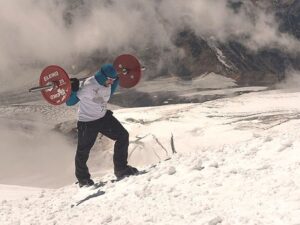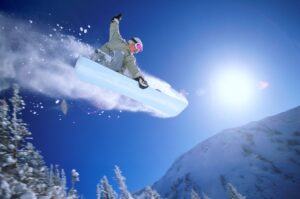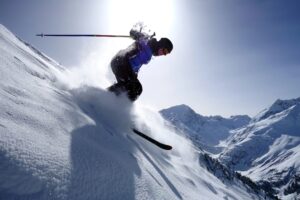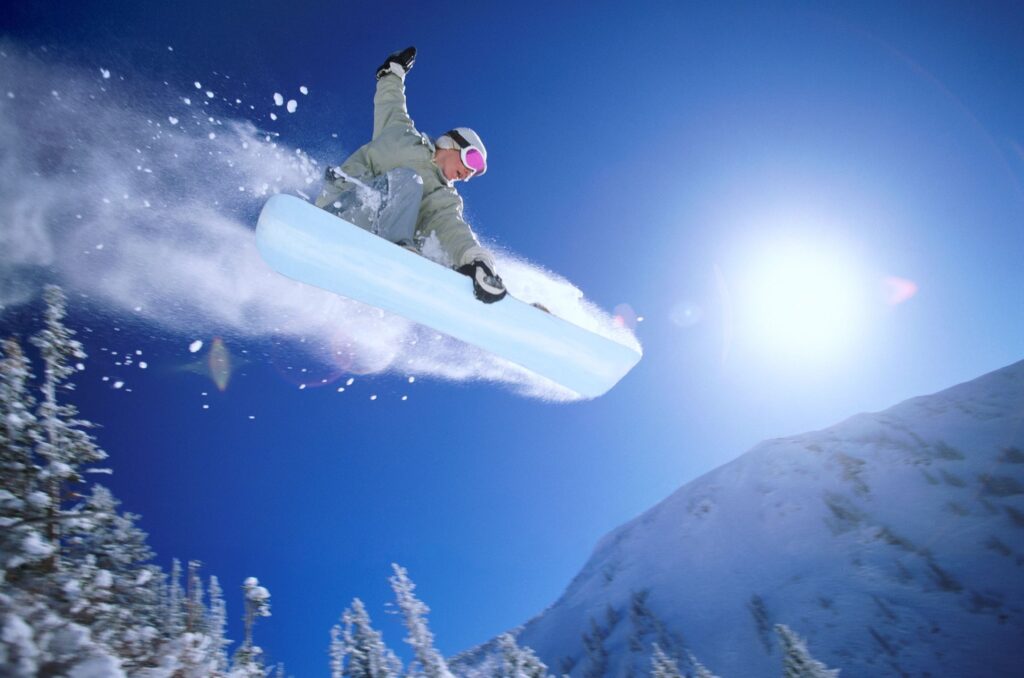Ski and snowboard season is fast approaching. Now is the time for skiers and snowboarders to “get in shape” for the slopes so you can crush it from first chair to last.
To most, this means cardio and legs, right? While that’s not a bad idea – you’ll certainly need strong legs and lungs this season – many powder hounds are missing out on a key component of training for their winter sports: upper body strength training.

Why Upper Body Training?
First and foremost, snowboarding in particular inherently involves falling, especially as you’re learning the sport. You’ll need strong pushing muscles to pop back up after a wipeout. Skiers may fall less frequently, but when you do fall, it’s somewhat more awkward to get back up, and thus even more essential to have upper body strength to do so. Not to mention, falls account for the majority of shoulder, elbow, and wrist injuries. The stronger your upper body muscles, the less like you are to injure them in a crash.
Secondly, upper body movements require “pillar strength.” This refers to bracing your core to support your spine as you push and pull heavy things. Performing unilateral (single-arm) exercises further enhances the anti-rotational demands on your core, which will help build stronger obliques that will help you make sharp turns on the slopes while protecting your body from injury.
Third, skiing and snowboarding are power sports. You need to be able to generate force as you move down the mountain. Power exercises like plyometric push-ups, push presses, push jerks, cleans, snatches, and med ball slams train upper body power that will translate to better force production on the mountain.
Fourth, from a recovery standpoint, you can’t just hammer your legs three or four times per week at the gym, then expect to perform well on the slopes. Training your upper body allows you to get into a consistent gym routine without trashing your lower body. That way, your legs have enough time to recover before your next powder day.
Finally, skiing and snowboarding are full-body sports. Yes, your legs do the bulk of the work, but your core (including your hips, lats, and shoulders) and upper body are responsible for stabilization and rotational force production that get you down the mountain safely and in style. If you’re a terrain park junkie, strong shoulders and obliques are a MUST for executing sick-looking 360s and grabs.
Okay, now that I’ve (hopefully) convinced you that you should be training your upper body if you want to be a more badass skier/snowboarder/human, here’s how to implement upper body training into your snow sport routine.
Ski Training Schedule

I use a 3-4 day split for ski training because it’s practical for most people’s schedules and allows downtime on the weekends to actually SKI when the season starts, which is the whole point, right?
Three training days:
- Monday – Full body push (squat + press)
- Tuesday – Full body pull (deadlift + row)
- Thursday – Full body + Conditioning
Four training days:
- Monday – Lower body strength*
- Tuesday – Upper body strength*
- Wednesday – Conditioning
- Thursday – Full body (higher reps, lighter weights)
In either case, Friday would be a “rest” or “get your ass up to the mountains” day, depending on whether the ski resorts are open yet. That leaves the entire weekend for crushing it on the slopes before you start the cycle over next week.
*Sunday was a wicked powder day? Swap upper and lower body strength days to give your legs extra rest.
Building Your Workouts
Okay, now for the structure of the workouts themselves. I won’t go into leg training, since this is an article about upper body. If you’re interested in other workouts for ski season, I posted your can’t-miss exercise guide HERE and a solid leg and core plan HERE (both links will open in a new tab for later reading).
When it comes to upper body training for snow sports, you should focus on movement patterns, rather than isolation exercises like bicep curls.
Your upper body is responsible for pushing and pulling movements. You can push and pull objects horizontally or vertically. That means there are four movement patterns to train on upper body days: horizontal pushes, like push ups; vertical pushes, like military presses; horizontal pulls, like rows; and vertical pulls, like chin ups or lat pulldowns.
You’re going to want to work in the “strength” and “strength-endurance” rep ranges for these exercises. For pure strength, that’s 3-8 reps per set at a fairly heavy or challenging weight. For strength-endurance, that’s 8-12 reps at a moderate, yet still challenging, weight.
It makes most sense to set up your sessions with strength work first, then higher rep, lighter weight exercises later in the workout.
 For instance:
For instance:
1) Barbell military press – 3×5, heavy
2a) Chin ups – 3×5-6
2b) Single-arm overhead press – 3×8/arm, moderate weight
3a) Single-arm DB row – 3×10/arm, moderate weight
3b) Push ups – 3x Max reps to fatigue (not failure)
4a) Seated cable row – 3×12, light-moderate weight
4b) Plank hold – 3x 45s
As you move through your workout, you’ll generally decrease the weights you use, but increase repetitions per set.
Note in the workout above that I’ve included several single-arm exercises. Unilateral pushing and pulling forces you to engage your core more-so than when you lift with both arms at the same time. This is because your obliques and deep stabilizing muscles must work harder to resist leaning over to the side or rotating. We call this “anti-flexion” and “anti-rotation,” which simply means your core is working double-time to keep you upright.
This is SUPER important for bulletproofing your body against injury, so much so that I’ve capitalized and bolded the previous statement. A strong core means a stable spine, which decreases your chance of wrecking yourself if you wipeout on the slopes. Do NOT neglect unilateral work when training for ski season! That applies to both upper and lower body training. Unilateral movements are essential for preventing injury inside the gym and out on the slopes.
Closing Notes
The entire point of training in the gym is to get better at the things you love to do in the great outdoors. If you want to have an Epic (or even Ikonic 😉 ski season, you would be remiss to leave upper body strength training out of your program.
Building a stronger upper body will increase your overall strength and endurance while decreasing injury risk to your shoulders, elbows, and wrists. Incorporating unilateral upper body exercises in your training plan will teach your core to brace and protect your spine, bulletproofing you for an injury-free season so that you can ride from the first fall storms all the way through spring skiing.

